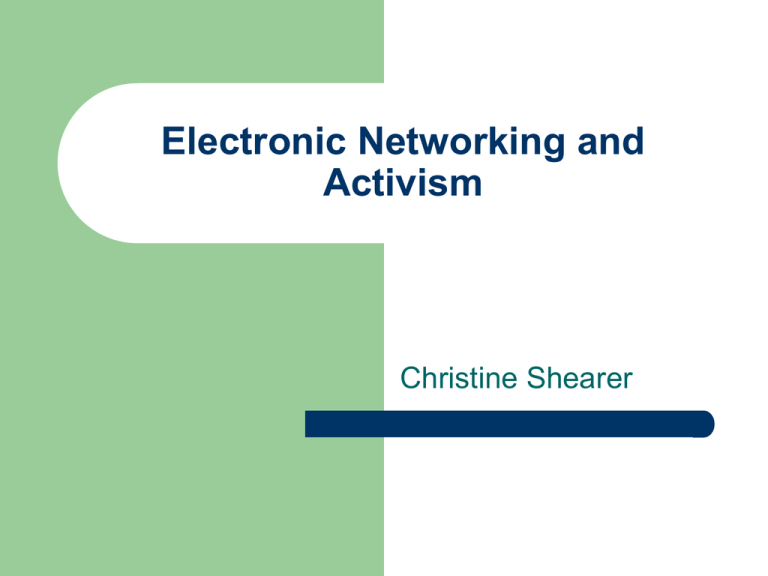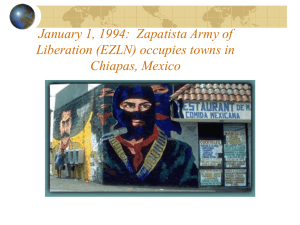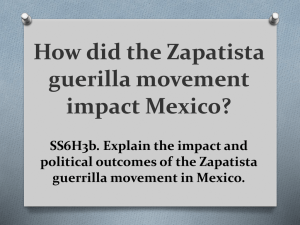Electronic Networking and Activism Christine Shearer
advertisement

Electronic Networking and Activism Christine Shearer 1950s U.S. Fordist Mode of production Assembly line – Mass production – Standardization – Vertically-integrated industry (within a nation-state) • Mirrored organization of social life: - Standardized nuclear family: husband at work, housewife - Mass consumption – 1970s Beginning of major changes in production, particularly: - Outsourcing of manufacturing from First to Third World Reluctance on the part of many social scientists to say the change was due to technology, because it comes off as technological determinism. Instead many globalization theorists ascribe the cause as decreasing returns on capital invested in production, leading corporations to send their manufacturing operations abroad where production costs are lower (i.e. wages, taxes, less regulations, etc.) New Mode of Production: Flexibilization Manufacturing becomes organized along global commodity chains, with each piece produced where it is most cost-efficient: – – – – “Just in time” production Subcontracting Flexible labor Containerization Globalization Decentralization of production necessitates tighter integration at level of command – – – Many corporations subcontract production and focus instead on the more profitable area of marketing, advertising, research and design, etc. Global cities (Sassen 2001) have the technological infrastructure to act as coordinating nodes in the global economy (e.g. NY, Tokyo) Idea of a “trans-national class” – elites whose interests lie outside any particular nation-state Fordism vs. Flexibilization Fordism - Mass production - Nation-state - Full-time work - Keynesianism - Autos/Electronics Flexibilization - “Just in time” - Trans-national - PT, Temp, Contract - Neoliberalism - Technology/Info Trans-National Activism As corporations take on a transnational perspective, political activists need to do the same. And as corporations use technology to make their activities more efficient, political activists should do the same. Structure of Activism Changing? - W. Lance Bennett (2003) – Social movements changing from top-down, bureaucratic structures (NGOs) to decentralized, horizontally-integrated direct action networks (DANs) [a big generalization and Bennett offers no actual examples, so it seems most useful to look at as ideal-type models] Role of Hackers According to Critical Art Ensemble (thanks, Alan) the “old-school” leftist activists need to link up with computer hackers. Old activists still targeting concrete structures, when the real damage to be done is in cyberspace, by blocking flows of info (i.e. the centralization of command discussed earlier). “Electronic Civil Disobedience” (ECD). Zapatistas Maria Torres (2001) went to Chiapas in 1993 as part of an electronic project to get local NGOs and popular orgs in Mexico “on-line.” The effect? - Just two days after rising up in Chiapas, Subcomandante Marcos was online, thus able to send the Zapatista message and subvert the reports of major Mexican media orgs. Ten days after that the Mexican army was called off, as people around the world held demonstrations supporting the Zapatistas. Precursor to the World Social Forum? In July 1996 the Zapatista call for a worldwide conference against neoliberalism brought over 3,000 people from five continents to Chiapas Zapatista Networks Garrido and Halavais (2003) mapped out the communication network of the Zapatista’s main site (www.ezln.org) and found it was linked with various global NGOs and was central to connecting many of them together [seems a somewhat obvious finding, which the authors admit, but it shows the degree of connection of the Zapatista struggle with other online activist groups]. Electronic Disturbance Theater Floodnet – – – Website that uses a Java applet to make browsers automatically reload targeted webpages several times per minute—all someone has to do is connect their browser to the website at a certain hour. Was used by EDT and Zapatista supporters as a form of “Free Speech expressed artistically on the Internet”—a virtual sit-in. (Debate on whether it’s legal, but EDT considers it ethical; it’s a “disturbance,” not hacking.) As the target, usually the Mexican President's website, is automatically reloaded, netizens could upload server log messages such as "human-rights not found on this server." Effect of Internet on Zapatistas To spread information from the Zapatista point of view To link up with other groups/orgs. To organize conferences To plan for and engage in electronic civil disobedience Inspired creative, electronic uses of free speech? Electronic Frontier Foundation Fighting for civil liberties in cyberspace – – – Group of legal and/or tech-savvy professionals and activists who use the law to fight against infringements of freedom in cyberspace. Carry on this battle mainly in courts, bringing and defending lawsuits often against the US Gov’t or big corporations. Also informs the press on tech issues and helps fund “freedom-enhancing technologies.” Activists and Hacktivists Common belief in liberty and freedom, and refusal to obey unjust laws. Striving for effective, efficient action. Hactivists who engage in electronic civil disobedience face the same penalties as activists who engage in civil disobedience: both are considered criminal acts (e.g. it’s illegal to intentionally cause damage to a website).



